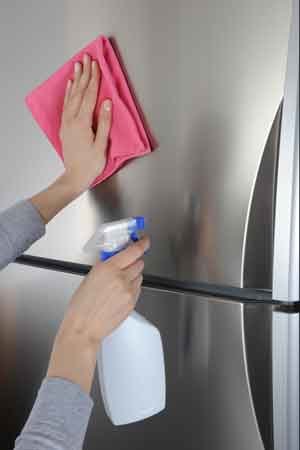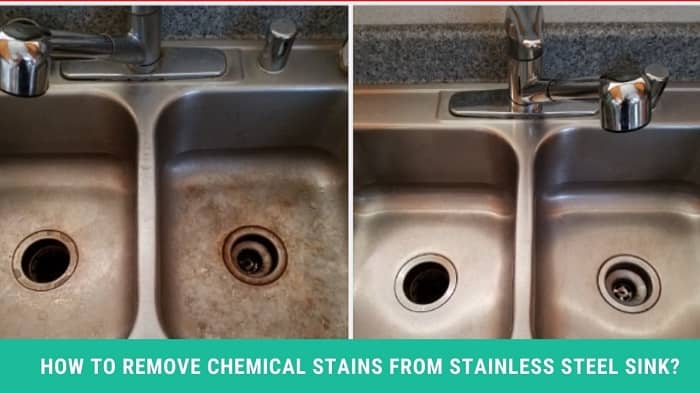It is quite normal for you to assume that stainless steel would be resistant to all types of stains, however, this is a common myth. Stainless steel, while less corrosive than conventional steel, does tarnish. So, how to remove chemical stains from stainless steel sinks?
The corrosion-resistant stainless steel surface is composed of a natural chromium oxide film. It can be found on all stainless steel surfaces, but especially those that have been exposed to air for extended periods of time owing to rusting.
Because of the protective layer, most stainless steel stains are easily cleansed, preventing individuals from using improper cleaning solutions or strategies.
Stainless Steel
Steel is composed of metal alloys or iron as the main component in ordinary steel. This metal alloy has up to 2% carbon and contains trace amounts of silicon, phosphorus, sulfur, and oxygen. Manufacturers, on the other hand, include a substantial amount of chromium in their alloys, ranging from 10% to 30% in stainless steel. They use nickel and manganese as well as other components. These two elements will help to increase the product’s durability and usability.
Furthermore, the combination produces non-magnetic stainless steel. Extremely hard chromium is created by combining oxygen and chromium oxides. The creation of a thin, continuous coating on the stainless steel surface is aided by this material. It will stop further corrosion as well as the production of ferric oxide (iron oxide). The best thing is that this layer is self-healing, meaning it will re-form if the metal is scratched.
How to Remove Chemical Stains from Stainless Steel Sink?
Undoubtedly, stainless steel could be a fantastic product for your kitchen sinks if you want to increase the beauty of your kitchen. But the question is how you will feel if you notice stains on the surface?
You will love to hear that, you can remove these chemical stains from your sink yourself by using low-cost items which are available in the market and in your house. Last but not least protective gloves and a face mask is a must be recommended two safety products you should use before starting the removal process.
Slight Chemical Stains
System 1: Steam Cleansing

- You’ll need a kettle and tap if the stains are light chemical. For this technique fill the kettle halfway with water and boil the water. Now take some paper tissue and place it on top of the sink to absorb all of the lint.
- Go ahead and rub them properly after they’re nice and moist perfectly with streams of water drips. Most crucial, you must avoid burning yourself during this procedure. Ensure there isn’t too much touch between the paper towel and the surfaces, and allow 10 minutes for everything to dry.
- After that, a second wipe-down is required, after which you can ensure that the cleaning process is complete swiftly and without difficulty.
System 2: Dish Liquid & Baking Soda

- Baking soda, a dishwasher, a basin, an old toothbrush, and a paper towel this equipment are all required for this method. You need to mix the components together and very important to ensure the same quantities of both products for the best outcomes.
- After that, you need to grab your old toothbrush and soaked it in warm H2O. Be careful the water will become red if it is too hot. It’s time to lightly brush stainless steel areas all along the surface until the stains disappear.
- Finally, rinse the place by raising small parts off the surface before washing off the entire sink and sides where no previous residue was present, then wipe all sink surfaces with a paper roll tissue or dry clean cloth.
Tough Chemical Stains
System 1: Combination of Freshwater & Ammonia

- All you’ll need is a cleaning towel, a bowl, ammonia, and a spray bottle. To guarantee that the carpets dry rapidly and that any surplus liquid is eliminated, use the sprayer. Now combine ammonia with warm water to make a smooth paste, also making sure the water is not too hot. You should ensure that the paste you are making is not too liquid or runny, and work with it carefully.
- Next, depending on the size of the stain, apply a 1/4-inch thick layer of paste to all spots and leave for 15 minutes, avoiding covering all regions of the stain. After wiping away all of the paste with a cleaning towel, clean up with a moist cloth.
System 2: Vinegar Formulation

- To apply this method, you’ll must need a paper towel and white or apple cider vinegar. Pour some vinegar on a paper towel and massage any liquid molecules from the sink away from the cloth or fabric surface until they disappear.
- Spray directly on top if you want more extra potency. Make sure there’s no direct contact between the garments, as this could result in irreversible damage, and let it rest for good 10 minutes. Now, using a paper tissue or clean napkin, gently wipe all of the filthy areas before wiping them away with a dry towel.
System 3: Cleaner for Stainless Steel

- Without any doubt, a stainless steel polisher and cleanser are excellent products you can use to remove harsh chemical tints so without having any problem. You should need to avoid harming or scratching those expensive surfaces and always ensure to read and follow the guidelines of the cleaners.
You May Also Read: How to Caulk a Stainless Steel Kitchen Sink
Types of Stains and Corrosion
A variety of causes I can show you for a stainless steel sink’s smooth, gleaming sheen can easily become clouded or tarnished. The good news is most of these stains you can easily remove by applying accurate products and methods, but some stains are permanent.
Below, I mention types of stains and corrosion for your further knowledge.
Hard or Abrasive Water: It is necessary to know that minerals from firm water can accumulate in any stainless steel sink. Calcium deposits easily cover it, and dissolved iron causes unattractive reddish rust stains you can find in many antique bathroom and kitchen fixtures.
Chlorine & Chlorides: Chlorine-induced pitting is basically a type of corrosion. It is valid for chlorides, which include table salt (sodium chloride). I can assure you that short-term exposure is not such a problem. Prolonged exposure can cause irreversible stains in the sink. For example- chlorine-bleached water can linger in a stainless steel sink.
Bimetallic Corrosion: Staining and corrosion are another great cause of leaving salty water in your sink for an extended period. If you leave anything that is composed of a different metal on the sink, like aluminum, then you should know that the exchange of electrons between the metals could corrode the sink.
Acid Staining: Another point is stainless steel can be stained by any liquid with a pH less than 1.0. Most importantly, an acid that comes with a low pH is also undoubtedly too powerful for everyday use, so I can say in this case, that certain sulfuric acid-based drain cleaners may qualify. It will be wiser if you do not put them in the sink.
Iron Staining: You might know that scratching your stainless steel sink with steel wool is a concern, but I can confirm that it is not the largest issue. There is a huge chance if fine bits of iron is left on the stainless steel surface then it might lower the chromium content, causing the sink to rust if it goes below 10%, and the rust and the iron that generated it can be removed by yourself. On the other hand, the chromium oxide layer is known as self-heal and does an amazing job to prevent further rust formation.
You May Also Read: How to Wash Dishes in a Single Sink: 10 Easy Step
The Best 10 Tips & Tricks
Learn how to care for and clean a stainless steel sink in your house by applying my top 10 tips and tricks to keep your kitchen looking spotless and brand new:
- If you want to avoid scratches, then add a bottom grid.
- You can keep your stainless steel sink clean by rinsing it and wiping it down whenever you use it.
- Vinegar is another life saver hack you can apply to remove hard water stains.
- Do not forget to use cotton cloths to clean water spots after use.
- Try to avoid leaving items sitting in the sink.
- Make a paste of baking soda to clean the stainless steel sink and make it shine.
- It will be great if you scrub it with club soda.
- Use a soft scouring pad to make it twinkle.
- Remember that steel wool should be avoided.
- To polish the sink, you can apply olive oil with the help of a piece of cotton cloth.
Conclusion
By providing all of the necessary methods and informative information above, I have already answered the question of how to remove chemical stains from stainless steel sinks. Most of us think that chemical tints are challenging and problematic to eliminate from any stainless steel sinks, as I have stated. But, thankfully, there is a solution, and if you follow the tips I provide, you will be able to aid yourself in this situation.
However, keep in mind that the methods I described above will surely differ based on the sort of chemical left behind. Also, how long has it been since it has been spilled on your stainless steel sink?
Regardless, I hope that all these techniques I mention may help you get rid of those stubborn chemical tints from your beautiful stainless steel sink. I can challenge you if you use the appropriate product and maintain proper hygiene it will be easier for you to remove any stubborn chemical stain from the sink.
